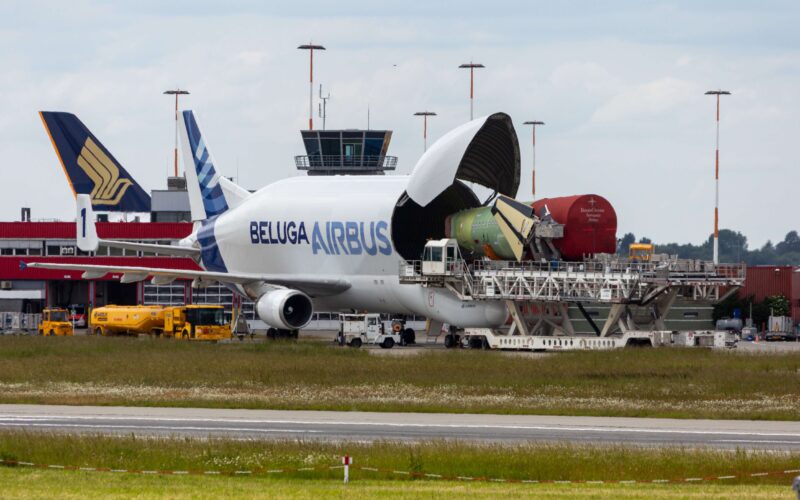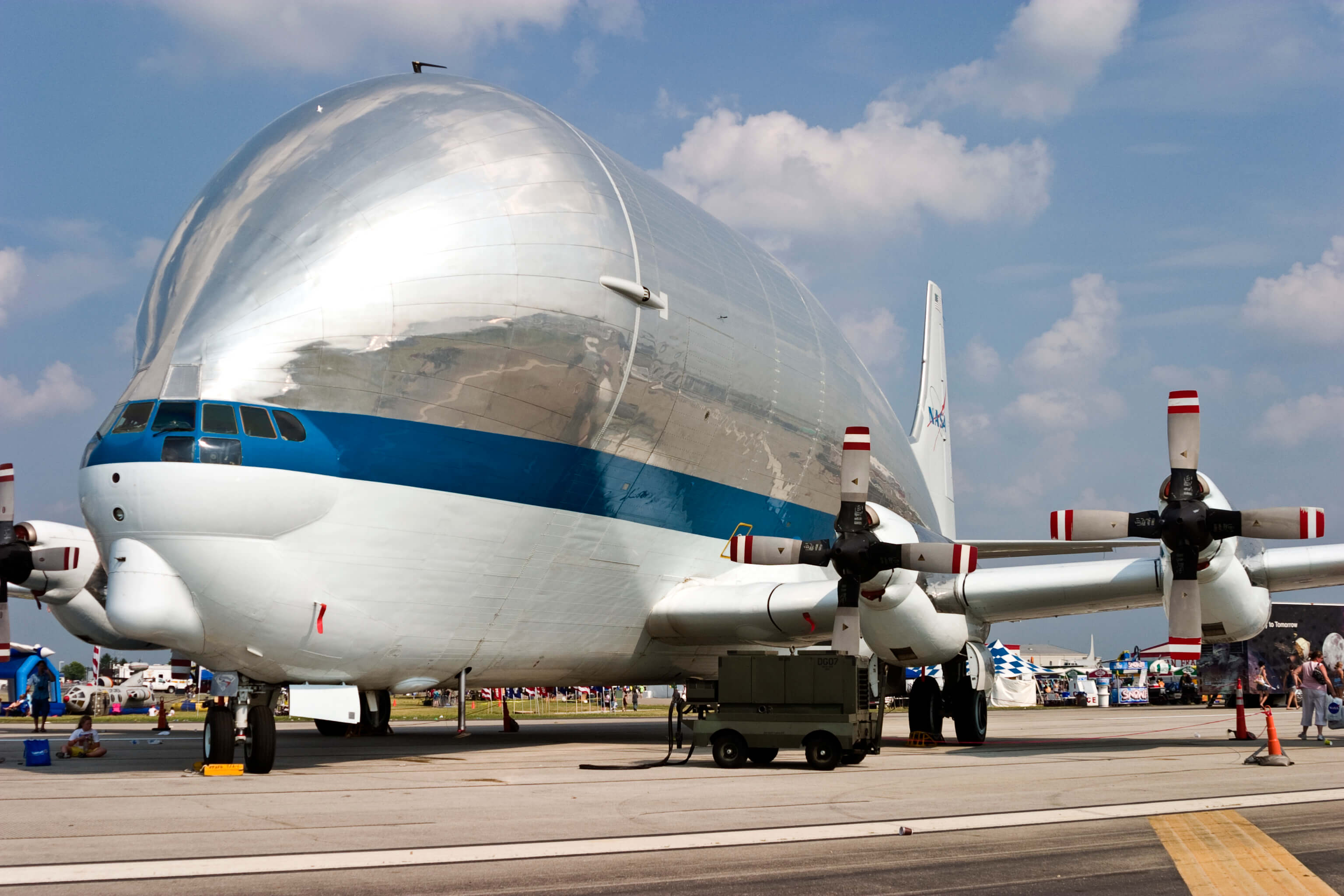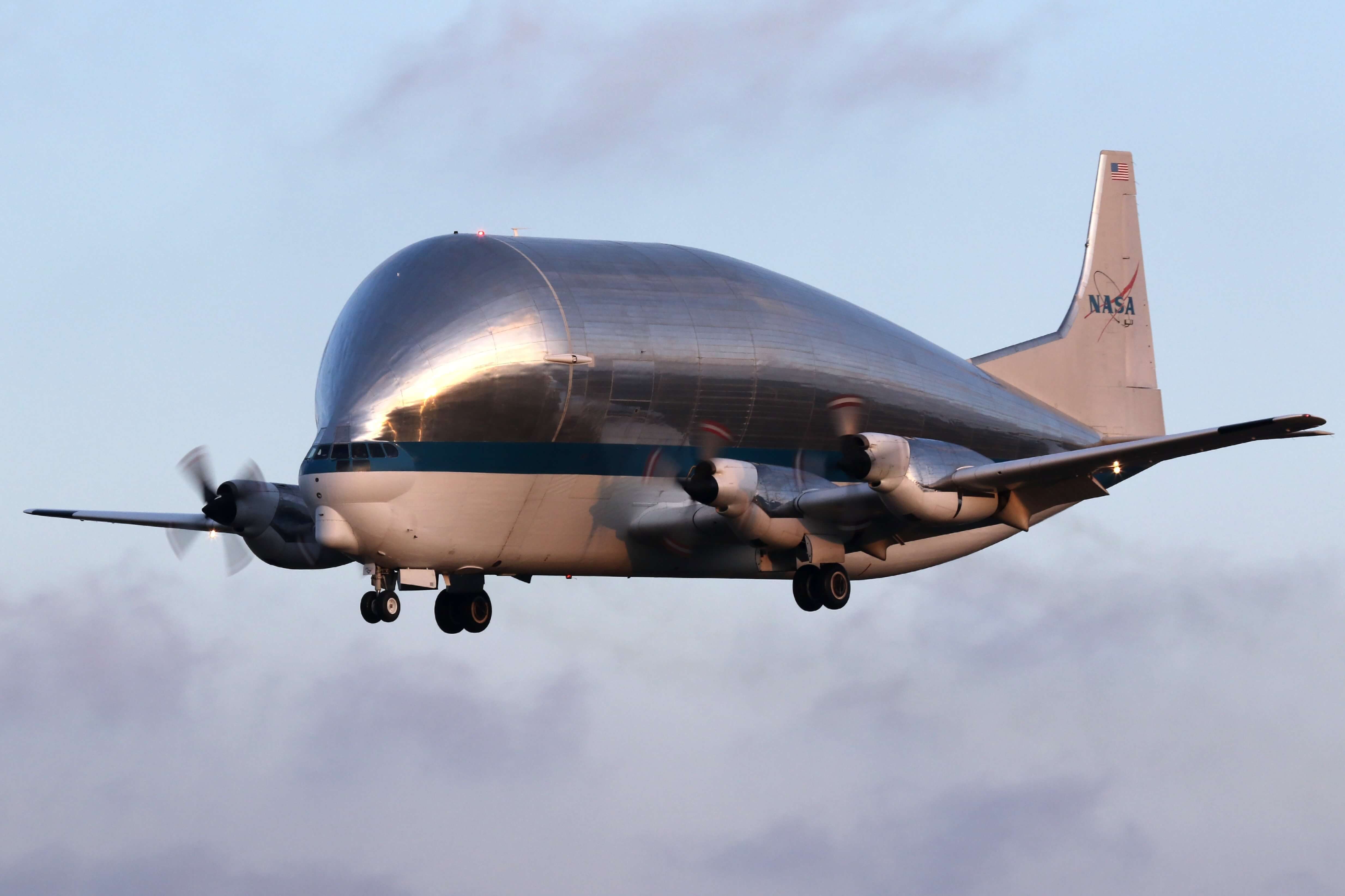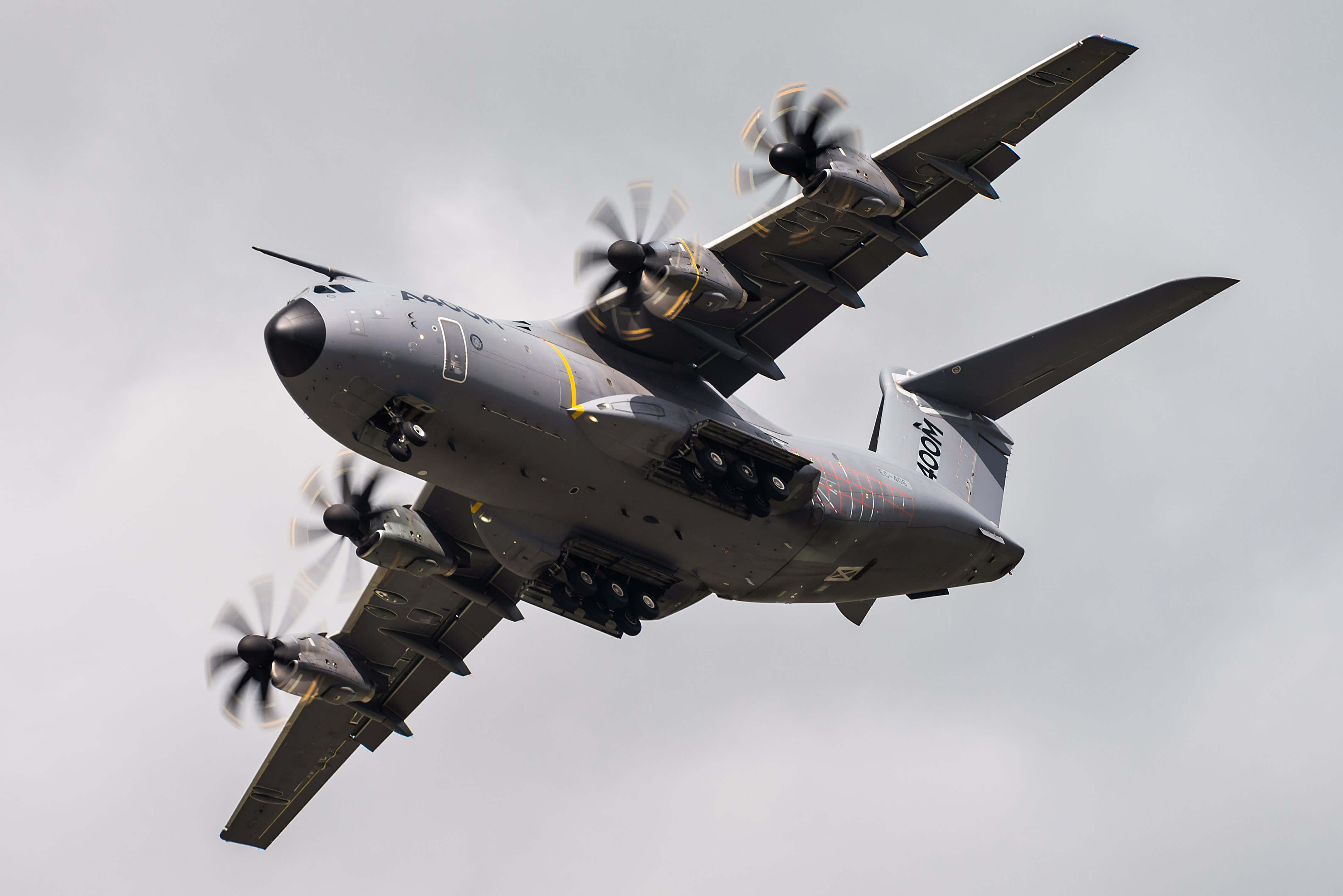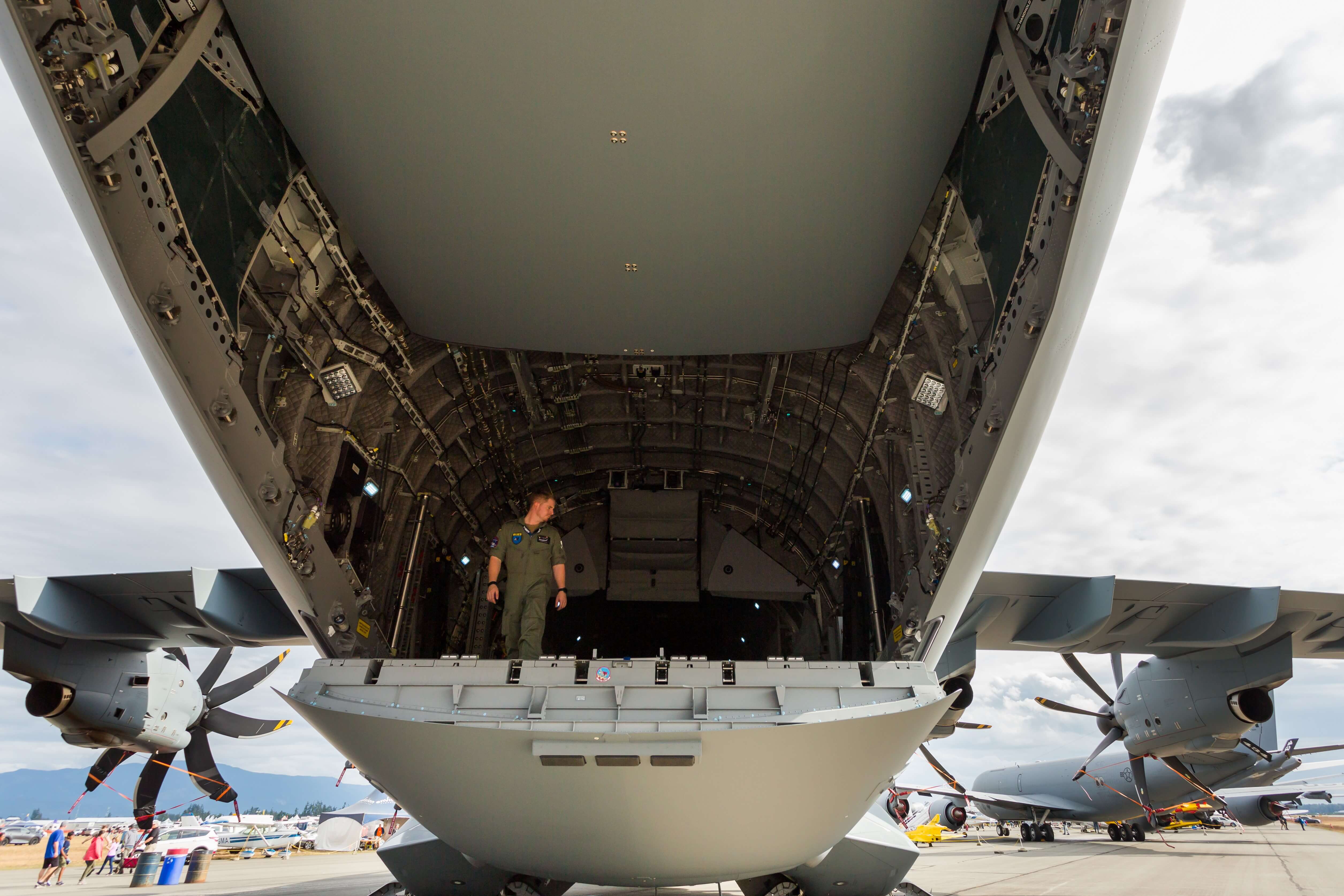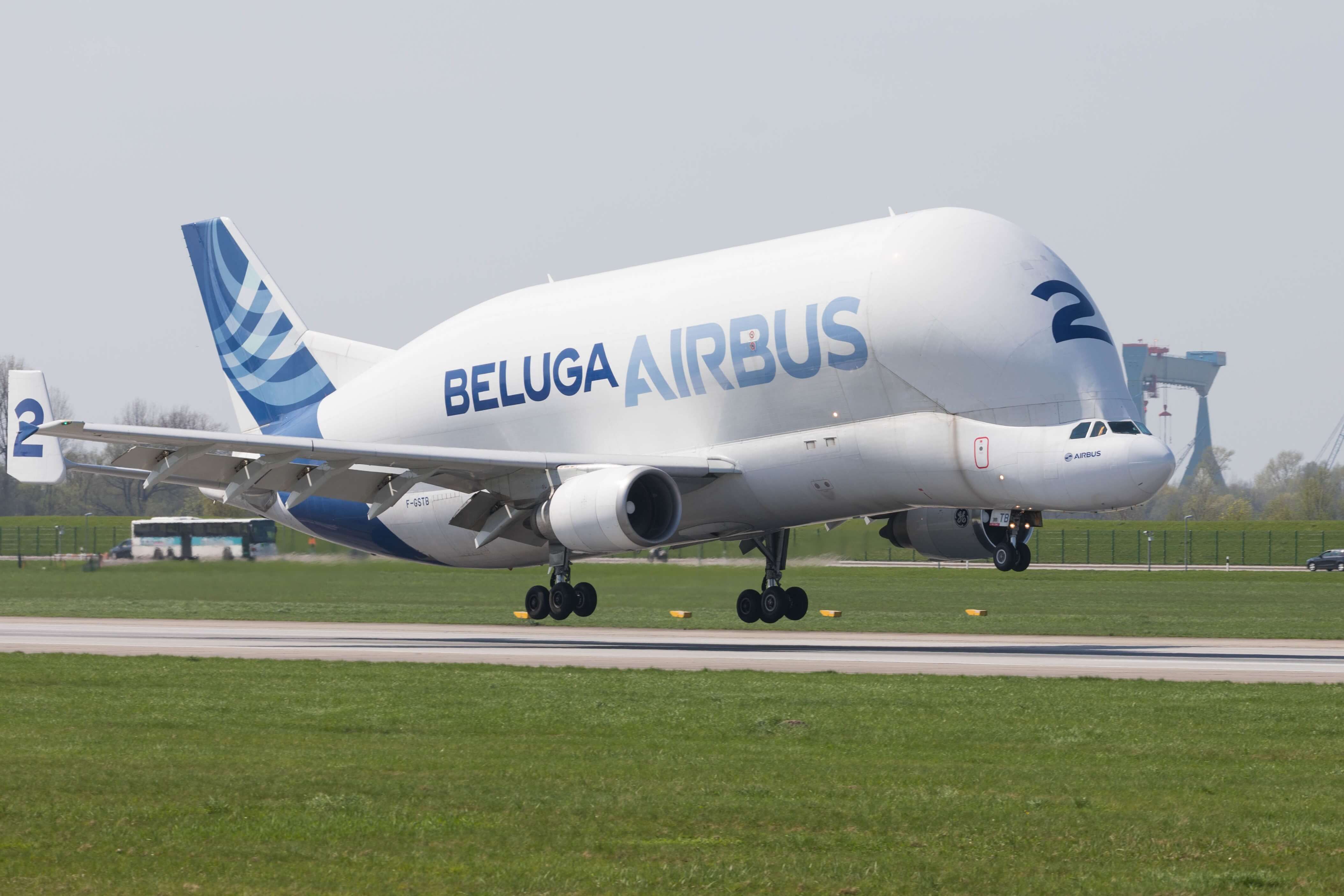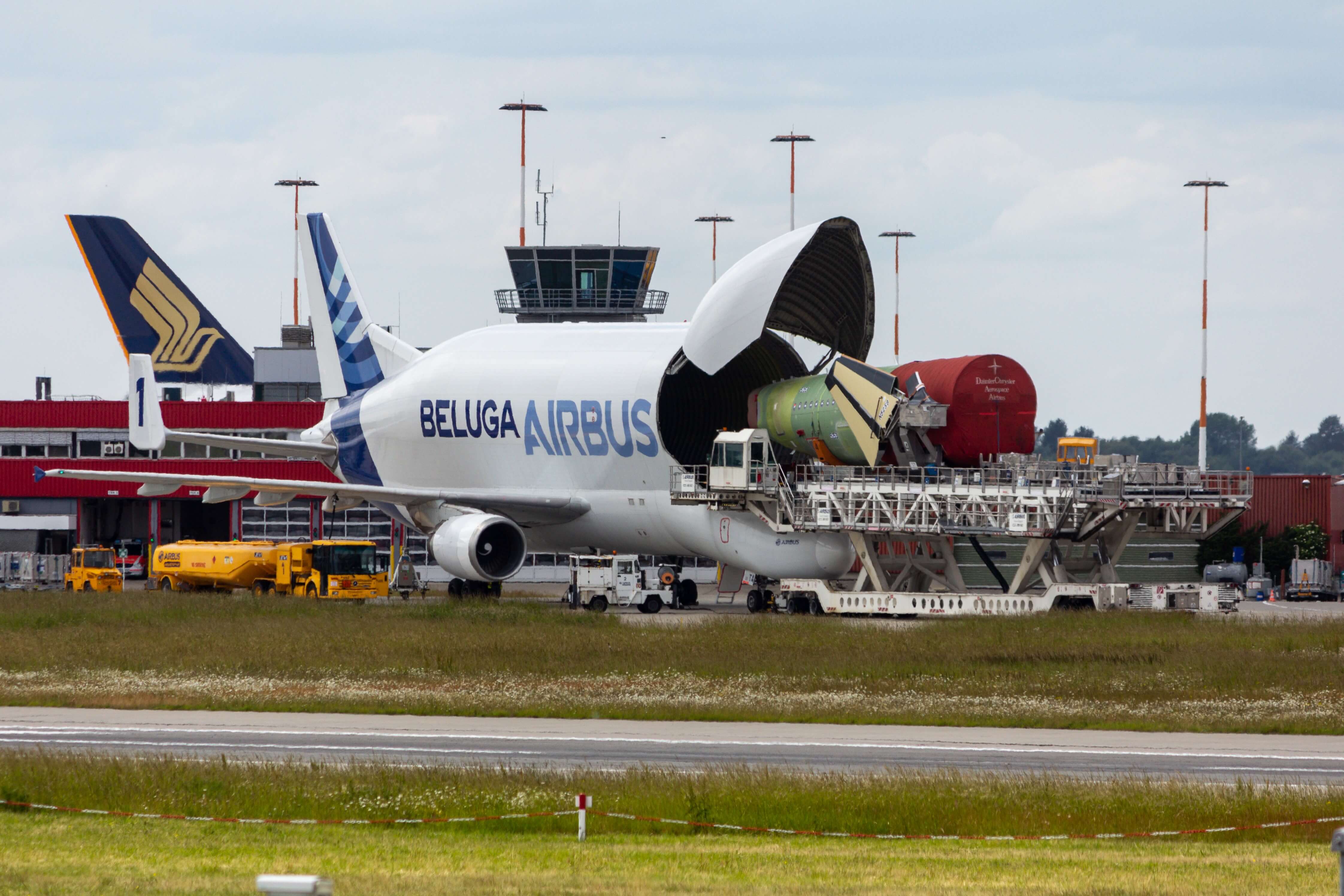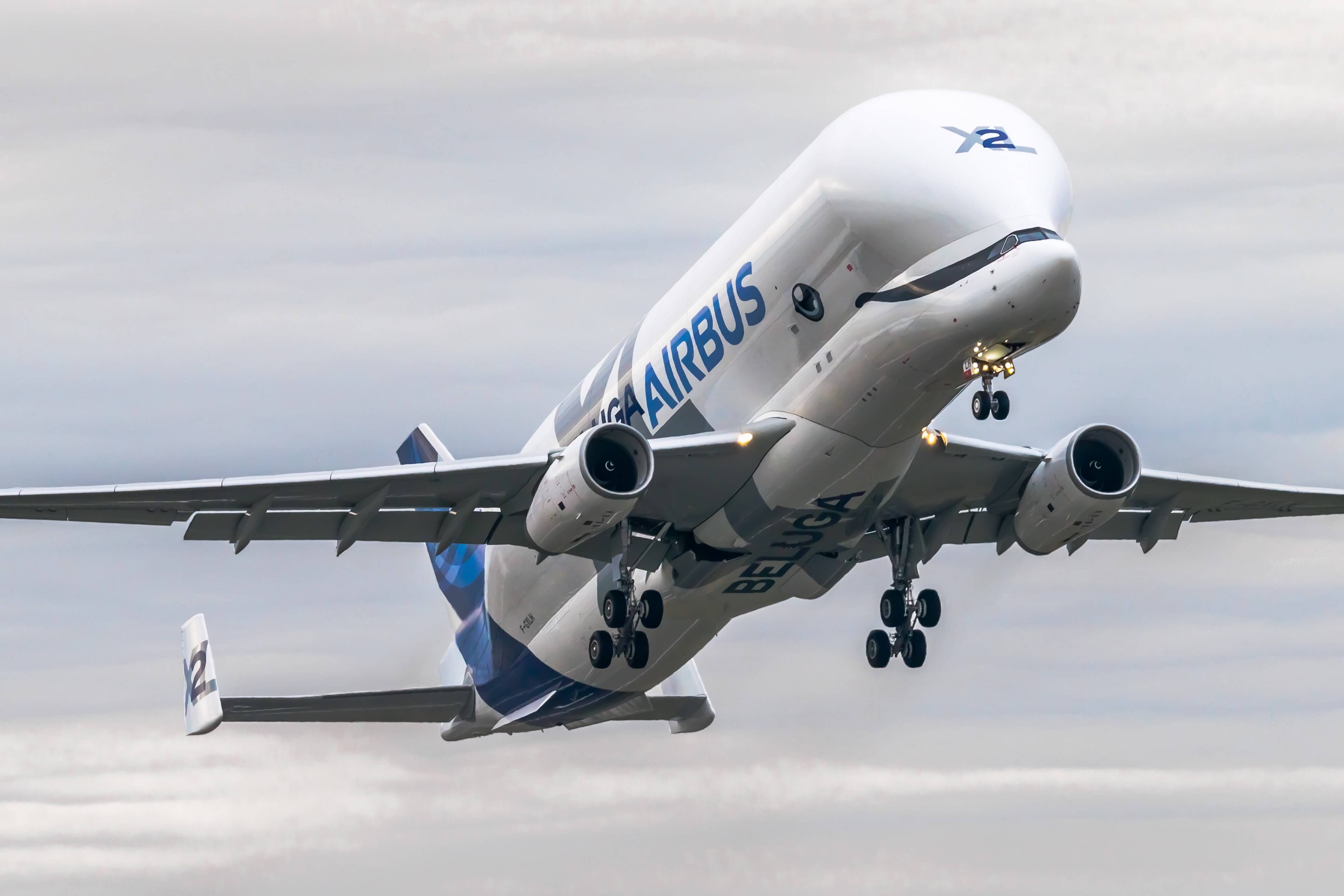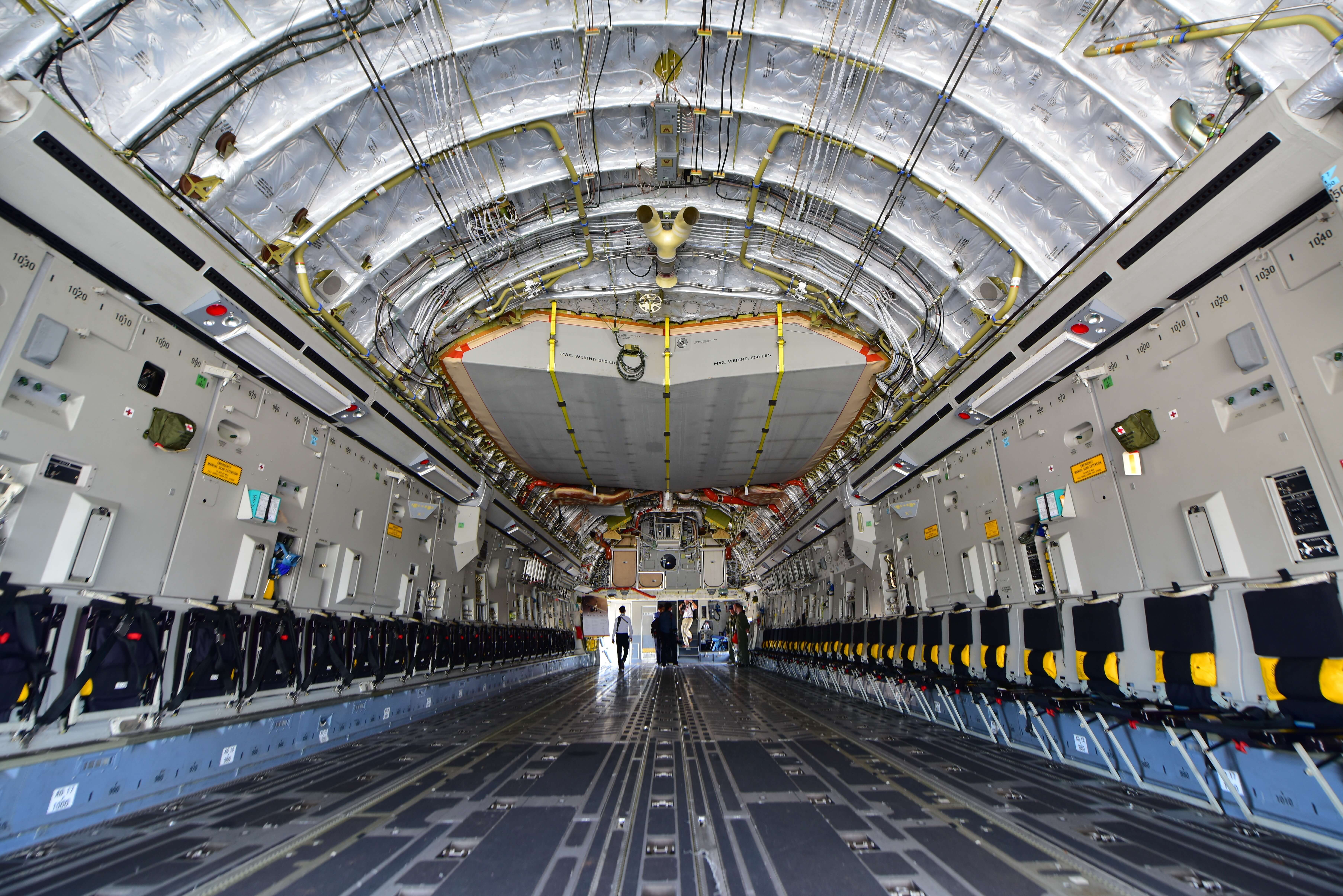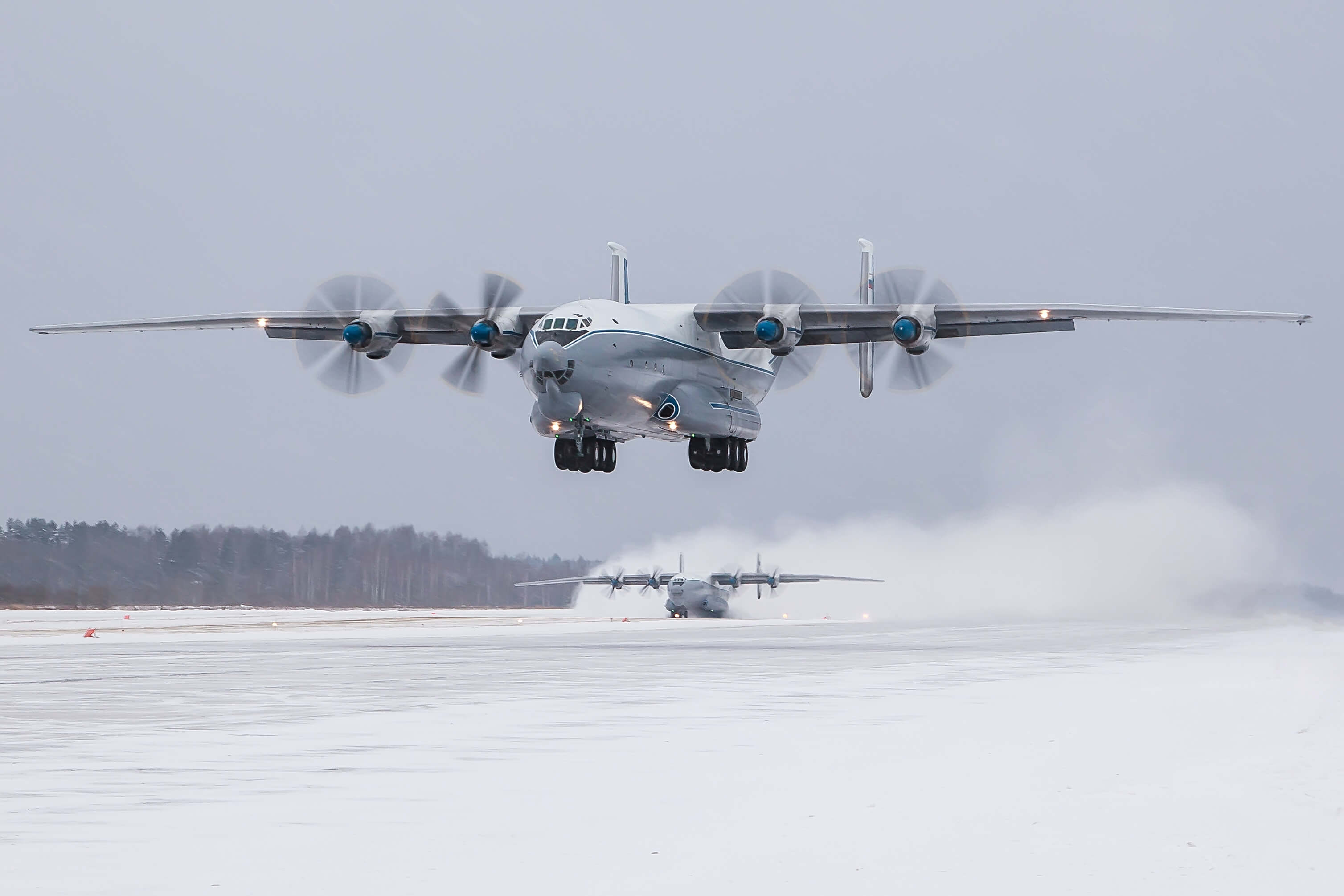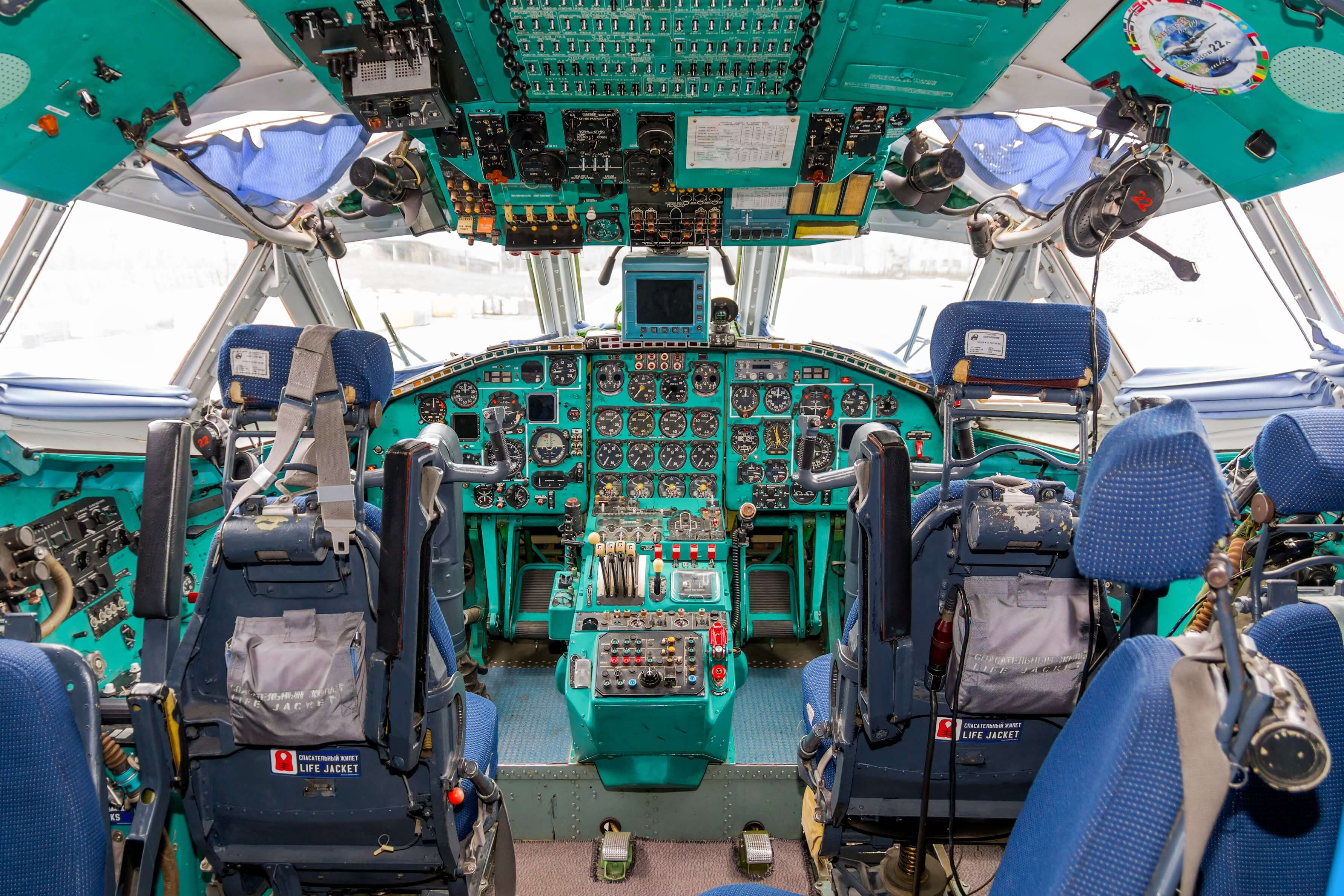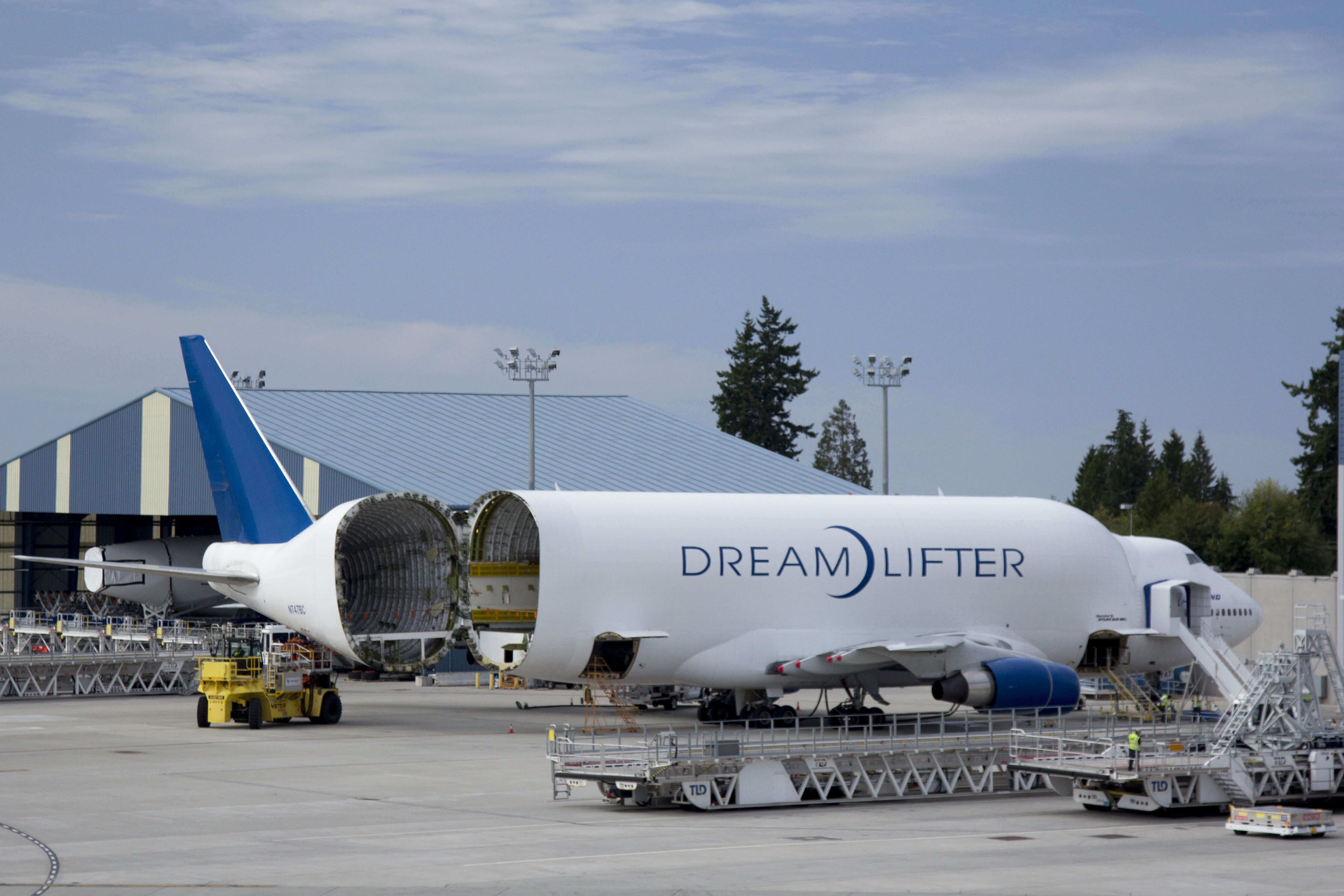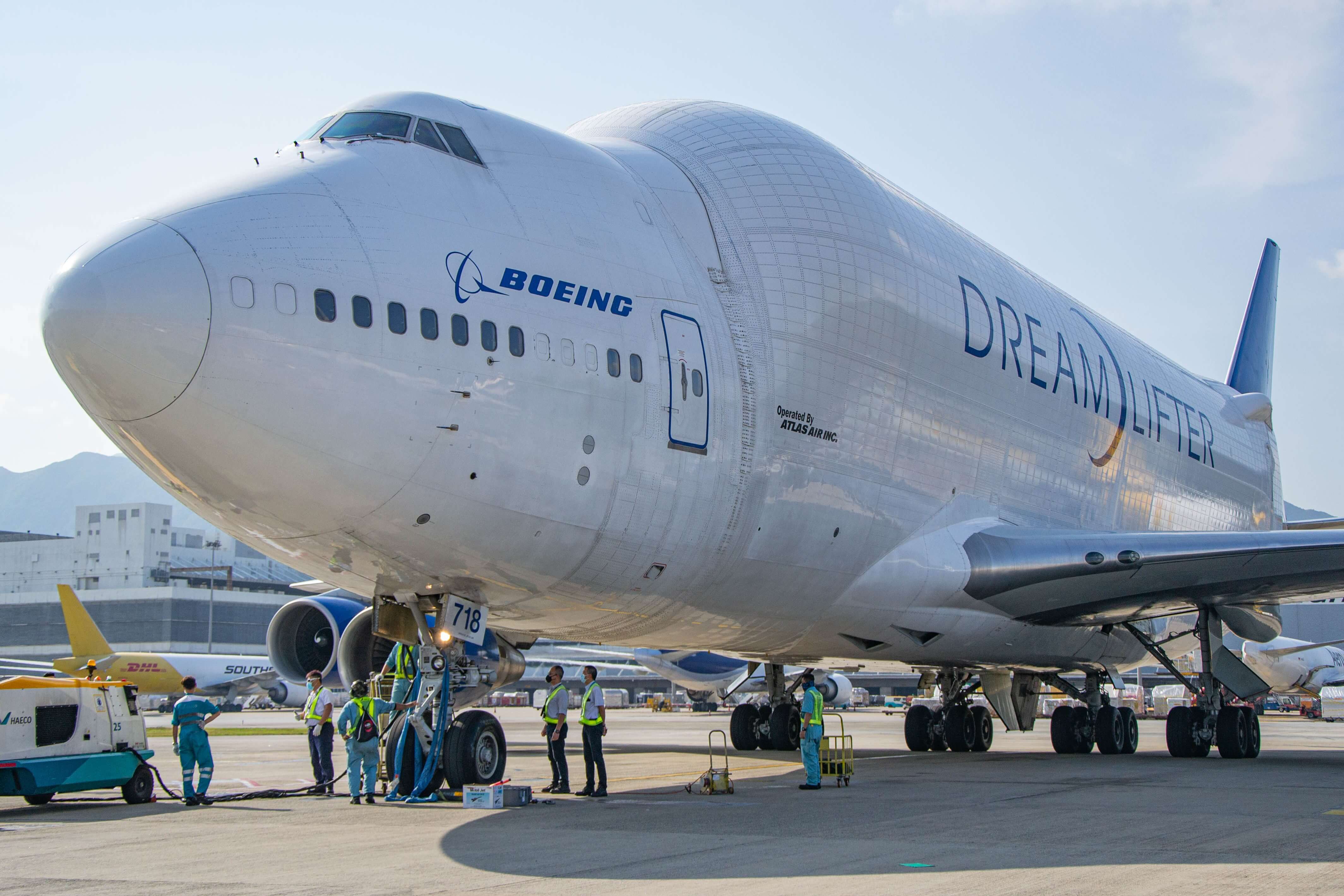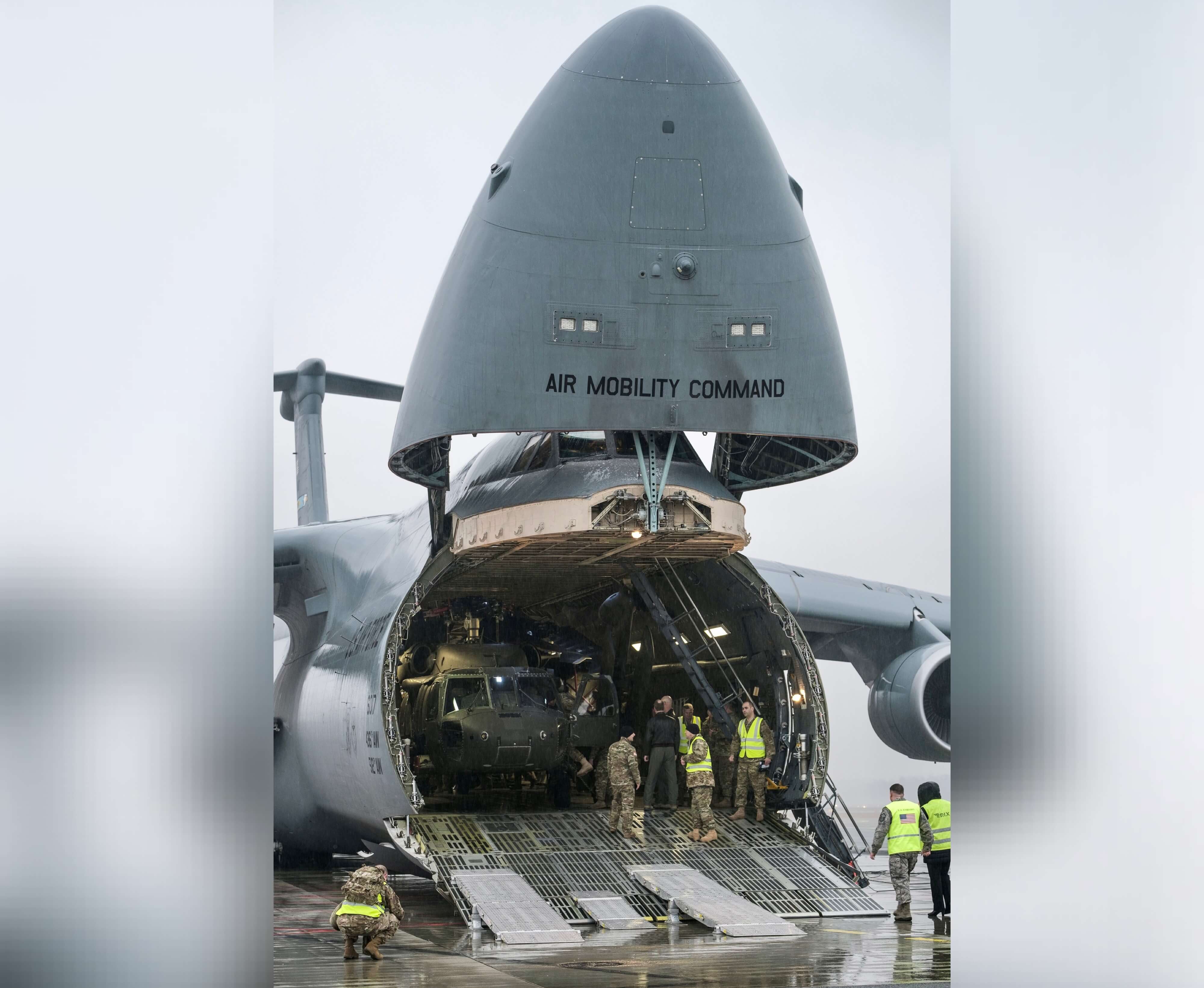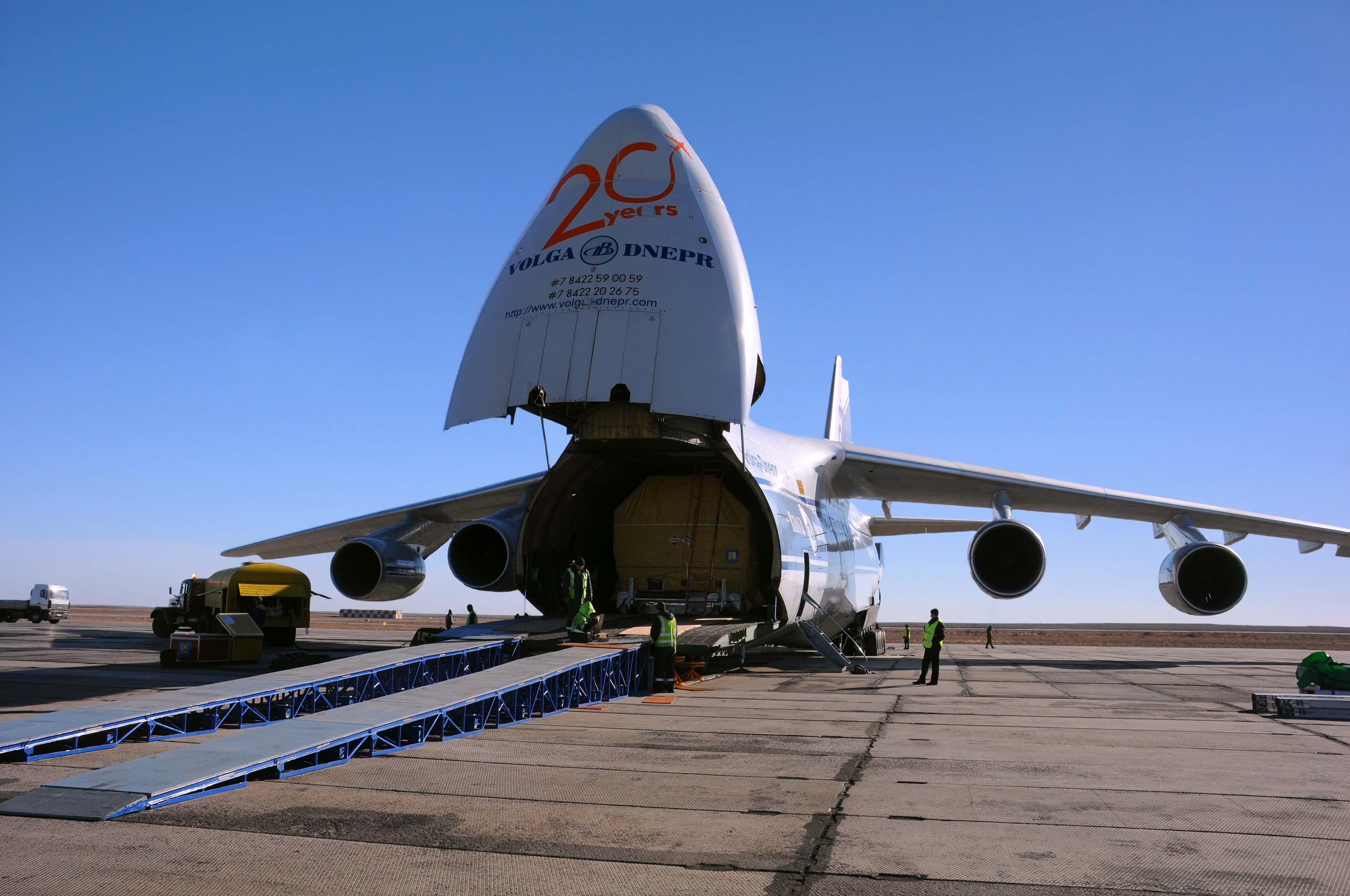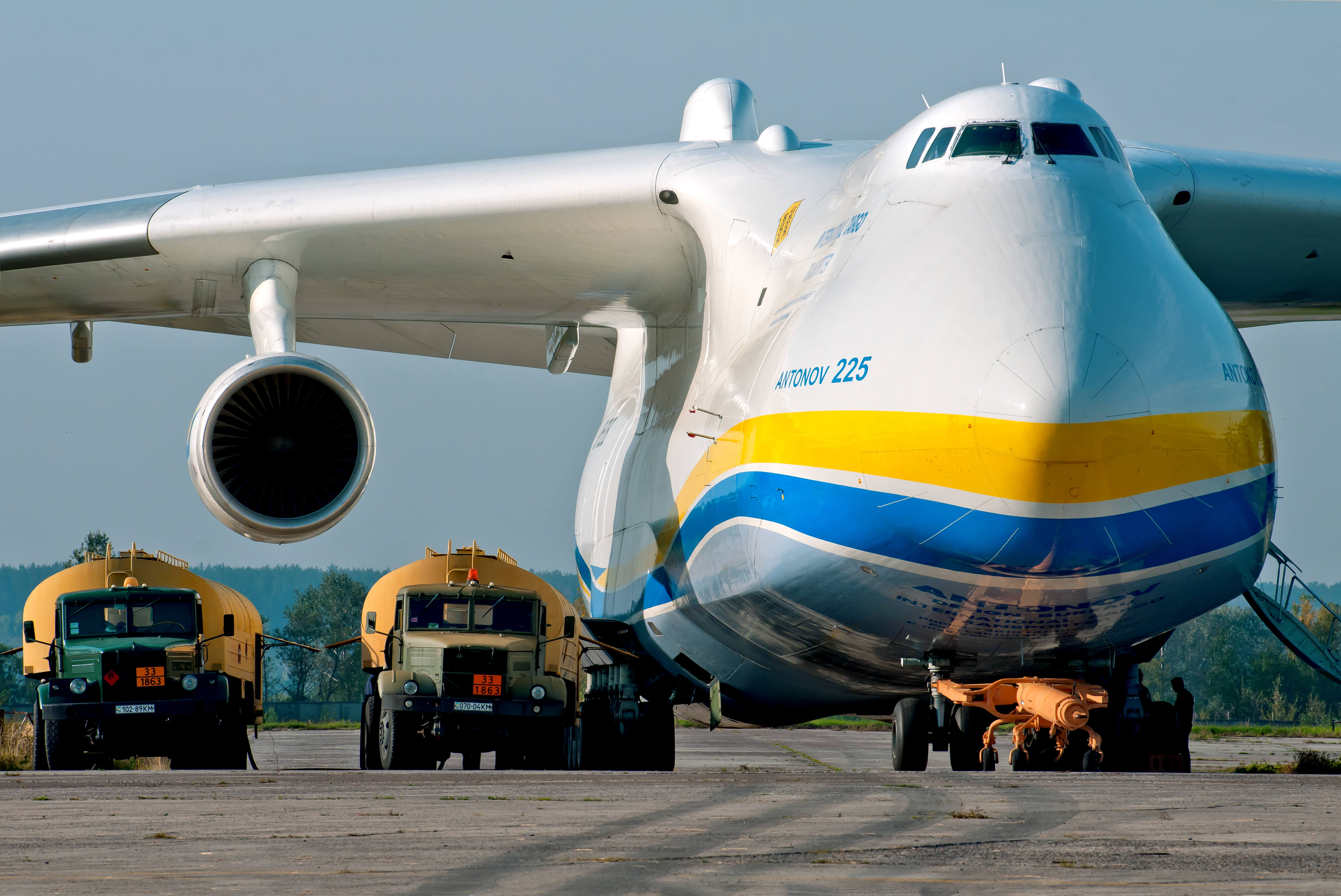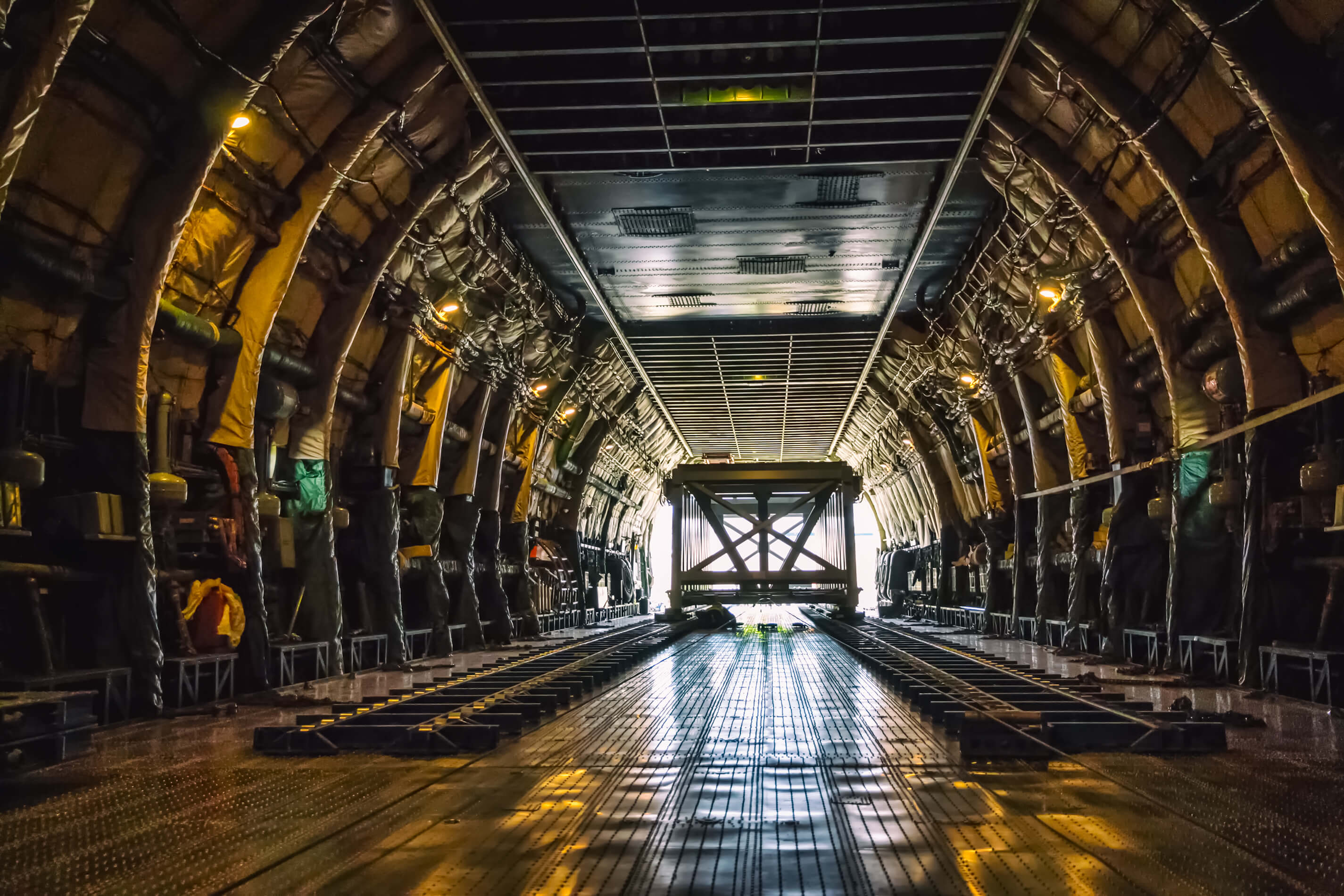Some cargo jets have a greater capacity than others when it comes to carrying unusually large or heavy goods. AeroTime investigates these cargo giants to determine which aircraft can carry the most freight.
10. Aero Spacelines Super Guppy
Some of the enormous freight loads flown by larger cargo aircraft are space-bound vehicles and components.
The Aero Spacelines Super Guppy is one such freighter that can carry these larger goods. This wide-body cargo aircraft is famous for its crucial role in the Apollo program and became the first and only plane in the world to fly Apollo IV rockets and other components in 1965. The Super Guppy was also widely used for flying spaceship components for NASA’s space missions.
Most recently, in November 2019, the Super Guppy was involved in transportation on the Orion spacecraft from Mansfield Lahm Airport (MFD) in the United States.
BlueBarronPhoto / Shutterstock
Operated by four crew members, the freighter is powered by four Allison 501-D22C turboprop engines, which allows it to develop a maximum thrust rate of 7,100 horsepower of each engine. The four-bladed turboprop can cruise at speed of 410 km/h (250 mph) and can reach a maximum speed of 460 km/h (290 mph) while flying as far as 3,211 kilometers without refueling.
Regarding cargo capacity, the Super Guppy can carry as much as 24,000 kilograms (54,000 lbs) of freight with a maximum takeoff weight of around 77,000 kilograms (170,000 lbs).
Since its introduction, only five aircraft have been built in two variants. To date, only a single Super Guppy remains in service with NASA. Another has already been scrapped, and three are on display for curious aviation enthusiasts to admire in the US, France, and Germany.
Karl R. Martin / Shutterstock
9. Airbus A400M Atlas
Another large cargo aircraft is the A400m Atlas, which was introduced by Airbus in 2013. The aircraft is a popular option for cargo operations in Malaysia and eight European countries, including Germany, France, Spain, the United Kingdom, Tukey, Belgium, and Luxembourg.
Four Europrop TP400-D6 turboprop engines provide the cargo jet with thrust equal to 11,000 horsepower. The aircraft can also fly as much as 37,000 kilograms (81,600 lbs) of freight and can carry 166 equipped troops as well as 66 stretchers accompanied by 25 medical personnel.
Atlas is not a leader among its competitors. But the aircraft still beats the Lockheed C-130 Hercules and the Transall C-160 in terms of its increased airlift capacity and range. The A400M was originally built to replace these two older freight transport aircraft.
SpaceKris / Shutterstock
Operated by three or four crew members, including two pilots (with an optional third) and a loadmaster, the jet is capable of reaching around 781 kilometers per hour (485 mph) speed with a range of 3,300 kilometers flying with a maximum load.
As for the A400M design, around 30% of its airframe is made of composite materials. For instance, its 42.4 meter-long (139 ft) span wing is made of carbon fiber reinforced plastic components.
As of May 2021, there were 100 Airbus A400M Atlas produced for freight operations.
Adam Melnyk / Shutterstock
8. Airbus A300-600ST / Beluga
There is no doubt that the ‘white whale of the skies’, the Airbus A300-600ST (Super Transporter), is one of the rarest and adored planes for plane spotters. Commonly known as Beluga, because it resembles the white Arctic whale, the super-sized transporter jet features one of the most voluminous cargo holds of any civil or military aircraft currently in operation.
The A300-600ST can be praised for its spacious cargo hold, which equals 1,500 cubic meters (53,000 cubic ft), allowing the plane to carry as much as 47,000 kg (103,617 lbs) of oversized freight. The freighter is typically used for the air transportation of chemical tanks, various aircraft parts, and space rocket components. For instance, it is capable of flying a fuselage section of an Airbus A350 wide-body plane, wings of the Airbus A340 aircraft, as many as 36 cars, up to 671 passengers, or seven elephants.
Beluga can be considered indispensable when transporting fragments of other aircraft. However, carrying certain freight, such as parts of the Airbus A380 superjumbo, is unattainable for this huge cargo airliner.
The white whale is powered by two General Electric CF6-80C2A8 turbofan engines, each generating a thrust of 58,000 lbs, and can attain a maximum speed of 864 kilometers per hour (537 mph) with a range of up to 4,600 kilometers without the need to refuel.
joerg joerns / Shutterstock
Flown by only two flight crew members, the Airbus A300-600ST retains the same flight deck as the A310 medium-to-long-range wide-body or the A300-600 mid-size wide-body aircraft, from which the white whale was modified to carry outsize cargo.
The aircraft has twice made aviation history. In 1997, the aircraft set a world record for flying the most voluminous payload by plane when the freighter carried a chemical tank for a merchant’s vessel from Clermont-Ferrand (CFE) to Le Havre (LEH) in France. Then, in 2003, the cargo jet was awarded once again after it flew the farthest charter flight to date, during which Beluga carried two NHI NH90 helicopters and one Eurocopter Tiger attack helicopter from Marseille (MRS), France to Melbourne (MEL), Australia. At the time, Airbus received a task to fly helicopters for the Aviation Airshow, which, excluding stops for refueling, was completed within 25 hours.
Since 1994, when the aircraft took to the skies for its maiden flight, the A300-600ST has played a key role in its manufacturer’s Airbus production distribution and assembly network.
Volar sin Parar / Shutterstock
The manufacturer has built only five units of the type and has already begun to phase in new-generation BelugaXL versions, which, in the future, will replace all five A300-600STs currently in service.
7. Airbus BelugaXL
The BelugaXL, the latest addition to Airbus’ transportation portfolio, was introduced in early-2020, as a promising replacement for its predecessor, the BelugaST.
In 2013, the five existing BelugaSTs were incapable of coping with Airbus production growth. So, the manufacturer began evaluating other freighters to ensure an uninterrupted logistics chain. However, none of the potential aircraft, including the Antonov An-124, the Antonov An-225, Boeing C-17 or Boeing 747 Dreamlifter, and the A400M, suited Airbus plans. Subsequently, the company spent around €1 billion to modify its existing A330-200 Freighter.
The newcomer entered the air cargo market providing 30% more cargo capacity than the older BelugaST. With a cargo hold volume of 2,209 cubic meters (78,000 cu ft), the Beluga XL can carry 50,500 kilograms (111,333 lbs) of freight up to 4,000 kilometer-long distances. Two Rolls-Royce Trent 700 turbofan engines each provide the cargo jet with 71,000 lbs of thrust.
The colossal Beluga XL possesses a distinctive fuselage design due to the lowered cockpit and a specific cargo bay structure. Its aft section is based on the A330-300, while the forward is based on the A330-200 owing to the center of gravity, and the reinforced floor and structure are derived from the A330-200 Freighter. Compared to the BelugaST, the fuselage of the XL is 6.9 m (23 ft) longer and 1.7 m (5 ft 7 in) wider.
tenora / Shuttertstock
Airbus launched BelugaXL operations in January 2020, with the expectation that a total of six new freighters would be in service by the end of 2023.
6. Boeing C-17 Globemaster III
First deployed in 1991, and in production until 2015, the Boeing C-17 Globemaster III is famous for its cargo systems. Boeing designed the aircraft to replace some duties of its predecessors, such as the Lockheed C-141 Starlifter and the Lockheed C-5 Galaxy. The Globemaster III is commonly used to perform strategic airlift missions, including medical evacuation, as well as transporting troops and freight across the world.
The T-tailed aircraft is designed to carry large or heavy non-palletized outsize cargo totaling 76,657 kilograms (169,000 lbs). It has a sufficiently large cross-section to carry large wheeled and tracked vehicles, tanks, helicopters, artillery, and weapons. The aircraft is capable of flying heavy freight, such as the 1 M1 Abrams tank, which is the main battle tank of the US Army, three Strykers, or six M1117 Armored Security Vehicles.
Powered by four Pratt & Whitney F117-PW-100 turbofan engines, each amassing 40,440 lbs of thrust, the aircraft is widely used by operators across Australia, Canada, Kuwait, Qatar, United Arab Emirates, the United Kingdom, and the United States. Its engine option allows the plane to reach a cruising speed of 830 kilometers per hour (520 mph) while flying as much as 4,480 kilometers without refueling.
Jordan Tan / Shutterstock
Crewed by two pilots and a loadmaster, the Globemaster III is most notable for its design. Its propulsive lift system allows the aircraft to achieve safe landings on short runways. According to Boeing, the plane is capable of landing a full payload in less than 3,000 ft. In addition, the propulsive lift system, which uses the engine exhaust to generate lift, allows the aircraft to fly a steep approach at a relatively low landing speed.
During the past three decades, the Boeing C-17 Globemaster III has experienced regular use. It has also broken 14 records, including its payload-to-altitude ratio. Most recently, in August 2021, the US Air Force transported 823 Afghanistan citizens from Kabul during a humanitarian mission, which established another record number of people carried by the aircraft.
Throughout its production history, Boeing has built 279 aircraft of this type.
5. Antonov An-22 Antei
First introduced in 1967 as the first wide-body military transport aircraft for the Soviet Air Force, the Antonov An-22 Antei currently holds the title of the world’s largest turboprop aircraft. Originally known as the An-20, the aircraft was built to increase the Soviet Airborn Troops’ capabilities to transport infantry fighting vehicles, BMD-1.
To accomplish such a task, the manufacturer installed four of the most powerful turboprop engines at the time. The Kuznetsov NK-12MA turboprop engines have two large, four-bladed, 6.2-meter (20 ft) high-speed contra-rotating propellers, each powering the aircraft with a maximum thrust of 15,001 horsepower. The selected engine option allows the freighter to reach a maximum cruise speed of 460 mph for a maximum range of 10,950 kilometers when its payload reaches 45,000 kilograms (99,208 lbs).
So, why does the An-22 deserve to be included in our list celebrating the largest cargo aircraft? Its enormous cargo hold capacity. The turboprop is capable of flying 80,000 kilograms (176,370 lbs) of freight as a maximum payload alongside a maximum of 29 passengers on board. The manufacturer completed the Soviet Air Force’s task and built the cargo hold capable of accommodating four BMD-1s, which is three more than its predecessor, the An-12, could carry.
pomogator / Shutterstock
Antonov mounted 12 wheels, six on each side and in the middle of the An-22 fuselage, and fitted the aircraft with rugged landing gear. This ensured that the aircraft was capable of takeoff and landing from austere, unpaved, and short airstrips.
The freighter’s specific design allows the rear cargo door to remain open while in flight in order to deploy paratroopers.
While production of the Antei ended in 1975 with the final 66th aircraft delivery to the Soviet Air Force, three turboprops are still airworthy.
photo vvl / Shutterstock
4. Boeing 747 Dreamlifter
The Boeing 747 Dreamlifter, or the Large Cargo Freighter (LCF), is a combination of two aircraft, the ever-versatile Boeing 747-400 and the Boeing 787 Dreamliner, which continues to satisfy plane spotters and cargo operators alike.
The history of the Dreamlifter, the world’s longest cargo aircraft, began in 2003 when the manufacturer realised that it needed to find a more time-efficient way to transport parts and components for the assembly of its 787 Dreamliner. Due to the length of time required to transport the Dreamliner’s parts by land or sea to the United States, air transportation seemed to be the most appropriate choice. Some of the Boeing 787 jet parts, such as wings, were too large for standard sea shipping containers. But the Boeing 747-400F freighter, Antonov An-124, and Antonov An-225, the available freighters, were also too small. So, Boeing developed a new aircraft dedicated to oversize freight transportation.
However, the manufacturer chose not to develop a completely new freighter. Instead, it converted four already existing passenger 747-400s, also known as the Queen of the Skies. During the conversion, Boeing made multiple changes to the 747-400 fuselage to ensure it was capable of carrying the outsize cargo and, to simplify the cargo loading process, installed a large swing tail door so freight could be loaded through the rear door.
Alex JW Robinsontter / Shutterstock
Boeing has only converted four 747s into Dreamlifters. The first 747 Large Cargo Freighter took off in 2006. The manufacturer equipped the cargo jet with the same engine option as the 747-400. The Dreamlifter is powered by four Pratt & Whitney PW4000 engines, generating 63,300 lbs of thrust, which allows the aircraft to fly at a speed of around 878 kilometers per hour at maximum.
The volume of the cargo hold is 1,840 cubic meters (65,000 cubic feet). It has a maximum payload capacity of 113,400 kilograms (250,000 lbs), which is three times more volume of freight than a traditional 747-400F. If fully loaded, the plane, which is crewed by two pilots, is capable of flying 7,800 kilometers without a refueling stop.
Heychli / Shutterstock
3. Lockheed C-5 Galaxy
The Lockheed C-5 Galaxy was introduced in the United States during the 1970s. The aircraft was widely used to supply Israel with aid during the Yom Kippur War and is also well-known for supporting the US space program, where it carried various spacecraft components.
One of the most notable facts about the Lockheed C-5 Galaxy is that, during its operating history, the manufacturer refitted the aircraft multiple times to solve issues with its wings. These problems were a result of the aircraft’s 169 fatalities from multiple crashes.
Kārlis Dambrāns / Wikimedia Commons
According to the manufacturer, the Galaxy is powered by four General Electric CF6-80C2 turbofan engines with 51,000 lbs of thrust. Typically, it is controlled by a crew of seven people, including a captain, a first officer, two flight engineers, and three loadmasters. As for cargo capacity, the Lockheed C-5 is capable of carrying around 127,459 kilograms (281,000 lbs) of freight while reaching its cruise speed of 830 kilometers per hour (520 mph) flying as long as 4,260 kilometers fully loaded.
131 Lockheed C-5 Galaxy aircraft have been built. These are mostly used for serving the United States Air Force operations.
2. Antonov An-124 Condor / Ruslan
The Antonov An-124 Condon, also known as Ruslan, was designed by a Ukrainian manufacturer in the 1980s. The An-124 used to hold the title of second heaviest operating cargo, following the An-225 Mriya, which was the first. But in 2010, the Boeing 747-8F freighter was introduced and beat the An-124 to first place.
Powered by four Lotarev D-18T high-bypass turbofan engines, each of them giving the plane 51,000 lbs of thrust, the Condor uses an oleo strut suspension [a pneumatic air–oil hydraulic shock absorber, ed.-] for its 12 pairs of wheels. The An-124 is capable of developing a maximum cruise speed of 537 mph flying as far as 11,500 kilometers with a payload of 40,000 kilograms (88,185 lbs).
The aircraft can handle a maximum takeoff weight of 402,000 kg (886,258 lbs) and is equipped with a high volume of cargo capacity to fly 150,000 kilograms (330, 693 lbs) of freight alongside 88 passengers in the upper deck, behind its wing center section, or 350 passengers on a palletized seating system.
To simplify the freight loading process, the manufacturer installed drive-on loading ramps as well as a variety of built-in freight handling equipment.
vicspacewalker / Shutterstock
Eight crew members are required on board to control this enormous cargo aircraft. This includes a pilot, a co-pilot, a navigator, a chief flight engineer, an electrical flight engineer, a radio operator, and two loadmasters.
Having made its maiden flight in 1982, production of the An-124 continued until 2014. The aircraft has frequently been used in missions for the member countries of the North Atlantic Treaty Organization (NATO). The manufacturer produced a total of 55 An-124s and, by 2021, there are 26 An-124s left in commercial cargo service.
In 1987, the An-124 became a world record holder after the aircraft flew 20,151 kilometers for 25 hours and 30 minutes without refueling and carrying a record takeoff weight of 455,000 kilograms (1,003,103 lbs).
Alex JW Robinsontter / Shutterstock
1. Antonov An-225 Mriya
The Antonov An-225 Mriya currently holds the title of the world’s largest cargo aircraft. The Ukrainian cargo aircraft, which is powered by six turbofan engines and equipped with 16 pairs of landing gear wheels, could be described as a relic of the Cold War. The giant plane was built in the 1980s when the now independent Eastern European country was a part of the Soviet Union.
The largest cargo aircraft of all time, which first took off in 1988, is well-known for its exceptional technical properties. According to the state-owned manufacturer, Antonov, the An-225 Mriya is capable of carrying ultra-heavy freights weighing 250,000 kilograms (550,000 lbs) internally, or 200,000 kilograms (440,000 lbs) on its upper fuselage, where the plane can fly as long as 70 meters (230 ft) long freight.
The enormous cargo hold allows the aircraft to fly oversized cargo, including military tanks, smaller aircraft fuselages, trains, or around 3 empty Space Shuttles, or 2 blue whales. Additionally, the plane is certified to carry up to 868 passengers across its two decks.
Popsuievych / Shutterstock
The aircraft is powered by six ZMKB Progress Lotarev D-18T turbofan engines, each producing around 51,590 lbs of thrust and helping to generate a cruising speed of 500 mph with a maximum speed of 530 mph. This allows the plane to fly a range that varies between 4,000 – 15,400 kilometers, or a maximum of 18 hours, without refueling.
The An-225 Mriya is also notable for its maximum takeoff weight of 640,000kg (1,410,958 lbs). In comparison, the largest passenger aircraft, Airbus A380-800, has a maximum takeoff weight of 575 tonnes.
The Mriya also boasts the largest aircraft wingspan, which reaches 88.4 meters (290 ft). If measured from nose to tail and wingtip to wingtip, the six-crewed freighter is the size of a standard football field.
Even though the aircraft is capable of flying exceptional sizes of freight, only a single Antonov An-225 Mriya has ever been built. In 1996, after serving the Soviet military missions for almost a decade, the giant joined the Antonov Airlines fleet for commercial oversized freight operations.
OPIS Zagreb / Shutterstock
In the late-1980s, a second Mriya was in the process of being built. It was supposed to operate flights for the Soviet space program. Due to the collapse of the Soviet Union in 1991, the aircraft construction process failed and the unfinished airframe of the second An-225 was put in a storage facility in Kyiv, Ukraine. While there have been multiple attempts to resurrect production of the second aircraft, doubts remain about whether the aircraft can be built any time soon.

